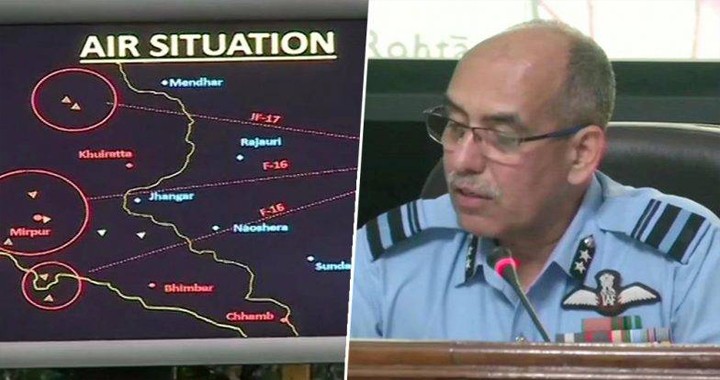
Today The Drive published an analysis Report on Indian Radar Data That Supposedly Proves They Downed An F-16. According to Author JOSEPH TREVITHICK AND TYLER ROGOWAY India’s evidence doesn’t come anywhere close to definitively proving what did and did not happen during the air battle over Kashmir in February.
On April 8, 2019, Indian Air Force said it has “irrefutable evidence” of shooting down an F-16 aircraft of Pakistan Air Force during the February 27 aerial combat. During a press briefing IAF Air Vice Marshal RGK Kapoor releases Alleged AWACS (Airborne Warning And Control System) radar images of the engagement area west of the Line of Control opposite Jhangar and claims that images clearly establishes that there was a bunch of F-16s opposite Wing Commander Abhinandan Varthaman. In a second image taken 10 seconds later, one of the F-16s disappeared. See Details and Press Briefing here: IAF says it has ‘irrefutable proof’ of shooting down PAF F-16, Shows Alleged Radar Image
IAF claims came a day after a highly circulated report based on unnamed sources from Foreign Policy stating that U.S. government officials inventoried Pakistan’s Viper fleet and found that none of them were missing. Details of Foreign Policy Report: U.S. personnel recently counted Pakistan’s F-16 Fighter Jets and Found None Missing
Indian Air Force claims of airborne early warning and control aircraft on the station had identified the F-16s and saw one of the tracks disappear from its screens completely can’t prove anything.
Here are the analyis byThe Driveon Report on Indian Radar Data
First thing is We have no way of knowing whether the images that Kapoor presented at the press briefing were taken directly from the radar outputs on AWACS, from a ground radar station or other integrated air defense network node, or were created from data from one or more of those sources specifically for the presentation.
Secondly, When Varthaman purportedly shot down the F-16, there were supposedly separate reports from Indian Army outposts along the so-called Line of Control (LOC), which separate the areas of Kashmir under Indian and Pakistan control, that troops had seen multiple parachutes falling on the Pakistani side in different, distinct locations. The MiG-21 is a single-seat aircraft, but it also has a drogue chute, which could have deployed inadvertently before it crashed, leading to the sightings of an additional parachute.
The third thing is IAF claims that they have radio communications intercepts of Pakistan Army formations in the area. However, the IAF has declined to share the intercepted radio communications themselves or a transcript thereof, making it impossible to independently verify the claims. “Due to security and confidentiality concerns, we are restricting the information being shared in the public domain
It’s also worth pointing out that India has not provided any evidence of the F-16 shootdown beyond the radar track “vanishing.” Kapoor only showed two still radar images, as well. Without having more data and context, we have no way of knowing conclusively that the contact disappeared and never reappeared or that it was an F-16, to begin with. Electronic warfare and the limitations of the airborne early warning and control system could have been factors, as well. The mountainous terrain and other ground clutter may have masked the Viper’s radar signatures temporarily and the fighter could have dropped into the “doppler notch” of the airborne radar system. There are so many possible explanations that cannot be ruled out without more information and at the very least, full motion video of the tactical picture, not just a few hand-picked screenshots.
Apart from that There is no indication that Pakistan launched any combat search and rescue effort to recover the crew of the purportedly downed F-16, which one might have expected to see, either.
Furthermore, it’s unclear why India waited more than a month to release this latest information, which still does not conclusively prove that the IAF shot down an F-16 in any tangible way. On Feb. 28, 2019, just a day after the aerial brawl, Indian authorities publicly showed the AIM-120C-5 fragment, which did offer compelling evidence that Pakistani Vipers had, at least, taken part in the operation overall.
Not surprisingly, Pakistan has denied India’s latest claims, while also reiterating their own unsubstantiated claim that Pakistani aircraft shot down a second Indian combat jet during the skirmish.
Repetitions don’t make truth of a lie. Despite claiming possession of evidence on shooting F16, IAF still short of presenting it. Don’t overlook Pakistan’s silence for not drum beating losses on Indian side. Fact is that PAF shot down two IAF jets, wreckage seen on ground by all.
— DG ISPR (@OfficialDGISPR) April 8, 2019
Pakistan has also released images of portions of Russian-made R-73 Archer and R-77 Adder missiles it recovered from the MiG-21 crash site as evidence that Varthaman never got off a shot. The remains of one of the close-range R-73s, which numerous reports say was the weapon that brought down the F-16, consists of just elements of the rocket motor and seeker head, raising questions about this claim. See Details here: IAF Mig- 21 Bison Wreckage Suggests that Indian pilot was Unable to Fire Single Missile
IAF claim of hitting F-16 by their Mig 21 before having been shot down by PAF gets exposed. All 4 missile seeker heads recovered intact from the wreckage & held. Pakistan and its professional Armed Forces staying humble by not drum beating. We have more truth on this to share. pic.twitter.com/jOklFU7GDJ
— DG ISPR (@OfficialDGISPR) April 5, 2019
India’s latest release of information is interesting, but it remains too circumstantial and limited to put the issue of whether or not the IAF shot down an F-16 to rest for good. The Indian government’s repeated claims, and the counter-claims of an audit of Pakistani Vipers, only seem to raise new questions about exactly what happened in the skies over Kashmir more than a month ago.
